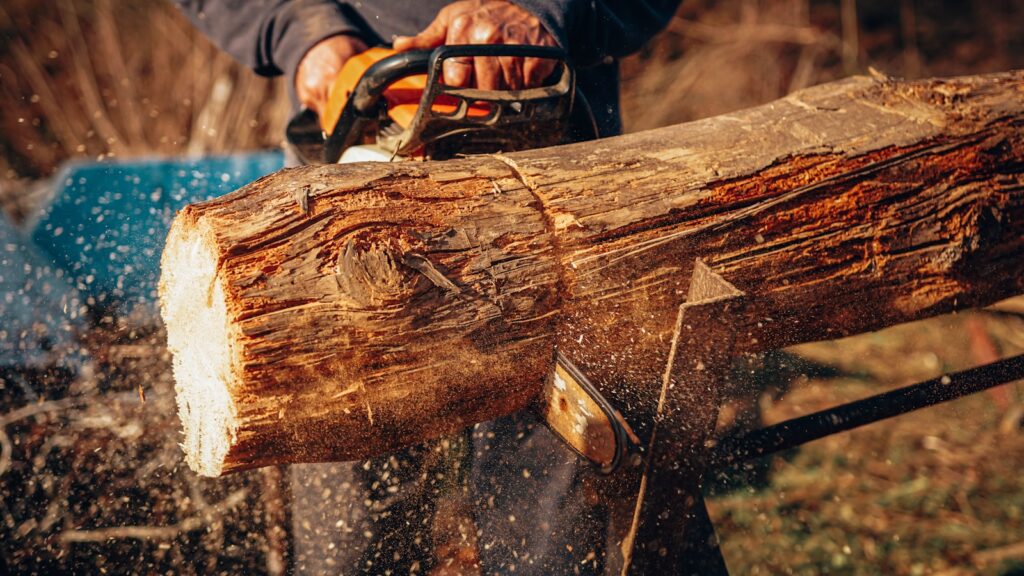5 Gas Chainsaw Safety Basics Every Beginner Should Know
A gas chainsaw can make outdoor work faster and easier, but it also demands respect and care. Every beginner must understand that safety comes before speed or strength. Learning the right habits from the start helps prevent accidents and builds confidence with each cut.
This guide explains the basic safety steps that protect both the user and the tool. It covers protective gear, equipment checks, proper stance, safe refueling, and chain care. By following these simple practices, anyone can handle a gas chainsaw with greater control and peace of mind.
- Always wear proper protective gear, including gloves, eye protection, earplugs, and chainsaw chaps.
Proper protective gear helps reduce the risk of injury while using a gas chainsaw. Each piece of equipment serves a specific purpose and should fit well to work effectively. Loose or damaged gear can create hazards instead of preventing them.
Eye protection keeps flying debris and sawdust out of the eyes. Goggles or safety glasses with side shields offer better coverage. Gloves protect the hands from cuts and vibration, giving the user a stronger grip on the saw handle.
Hearing protection, such as earplugs or earmuffs, reduces noise exposure. Prolonged use of a chainsaw without it can lead to hearing loss. Chainsaw chaps or pants provide a layer that can slow or stop a moving chain before it reaches the skin.
Anyone handling easy-cut gas chain saws should inspect their gear before each use. Small tears, cracks, or worn straps can reduce protection. Replacing damaged items right away helps maintain safe working conditions.
- Check the chainsaw’s safety features, such as the chain brake and throttle lock, before use
Before starting a gas chainsaw, the user should confirm that all safety features work properly. The chain brake, throttle lock, chain catcher, and right-hand guard each serve an important purpose in preventing accidents. A quick inspection helps avoid problems that could lead to injury or equipment damage.
The chain brake stops the chain almost instantly if a kickback occurs. The user should test it by running the saw at low speed and engaging the brake to verify that the chain stops right away. If the brake fails or feels weak, the saw should not be used until repaired.
The throttle lock prevents the chain from moving unless the user presses a separate control. This feature stops accidental acceleration during startup or handling. In addition, the spark arrestor and chain catcher should be clean and secure, since they protect against debris and broken chain links. Regular checks keep the saw safe and ready for proper use.
- Maintain a firm grip with both hands and stand with a stable stance to control kickback
A firm grip helps the operator keep control of the chainsaw, especially during sudden movement. The left hand should stay on the front handle and the right hand on the rear handle. This position gives better balance and control over the saw’s motion.
A stable stance supports safe operation. Feet should stay shoulder-width apart with weight spread evenly. This posture allows quick reaction if the saw jerks or shifts unexpectedly.
Kickback happens when the tip of the guide bar touches an object and forces the saw upward. A strong grip and balanced stance reduce the chance of losing control. Therefore, users should always stay alert and ready to adjust their hold or footing as needed.
Proper body position not only limits injury risk but also helps maintain steady, accurate cuts. Each movement should stay deliberate and controlled to keep the chainsaw stable throughout use.
- Refuel the chainsaw only when the engine is off and cooled to prevent fire hazards.
A chainsaw engine and exhaust stay hot for several minutes after use. Touching or refueling too soon can cause fuel vapors to ignite. Allow the saw to cool fully before opening the fuel cap or adding fuel.
A safe refueling area should be open, dry, and at least ten feet away from any ignition source. This includes fires, cigarettes, and equipment that may spark. Good airflow helps prevent fuel fumes from building up.
Use a proper fuel container and pour carefully to avoid spills. Wipe away any fuel that drips on the saw or ground. Restart the saw only after moving it away from the fueling spot.
Regular checks of the fuel cap and tank help prevent leaks that could lead to accidents. A few extra minutes of caution protect both the user and the equipment from fire hazards.
- Keep the chain sharp and properly tensioned to reduce the risk of accidents
A dull or loose chain can cause a saw to jerk or cut unevenly. This makes the tool harder to control and increases the chance of injury. A sharp chain cuts smoothly with less effort and keeps the saw stable during use.
Proper tension also matters. The chain should sit snug against the guide bar but still move freely by hand. If it sags, it can slip off the bar. If it’s too tight, it can wear out the bar and chain faster.
Regular checks help keep the chain in good shape. Before each use, they should inspect it for dull teeth or slack. Adjusting the tension and sharpening the teeth as needed helps maintain safe and steady cutting.
Following the manufacturer’s directions for tension and sharpening helps extend the life of the saw and reduces maintenance costs. A well-kept chain supports both safety and performance in every cut.
Conclusion
Gas chainsaws demand respect and attention. A beginner who understands the basics of gear, maintenance, and safe handling can reduce accidents and work more efficiently. Each habit built early supports safer use over time.
Proper preparation and awareness matter as much as skill. A user who checks the saw, wears protective gear, and follows correct cutting methods protects themselves and those nearby.
Safety does not end after a single use. Regular practice, inspection, and care help keep both the tool and operator in good condition. By following these simple steps, beginners can handle a gas chainsaw with confidence and control.





